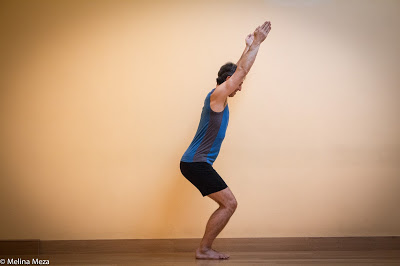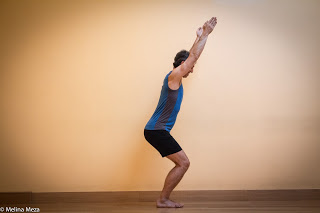by Baxter

Because Powerful pose strengthens the muscles in your legs, it is one of most helpful poses for maintaining your ability to move from sitting to standing with ease as well as for improving your balance. Additionally, Powerful pose strengthens some arm and upper back muscles, while also stretching your chest and the fronts of your arms. The three variations described below make this pose accessible to almost anyone.
Baxter prescribes this for:
- improving knee strength and healthy knee alignment
- recovering leg strength lost due to illness
- getting in shape for intense physical activity, such as skiing and hiking
- improving balance for those who can’t yet balance one foot or building leg strength to maintain balance
- improving shoulder mobility
Timing: For newer practitioners, hold the pose for 6-8 breaths. After a short rest in Mountain pose, repeat once or twice. For more experienced practitioners, work towards holding the pose for 60-90 seconds (around 16-24 breaths), and repeat at least once after a short rest. You can also do this pose dynamically, moving in and out of the pose from Mountain Pose, for 6-8 rounds.
Cautions: Those with knee arthritis or pain in the knee area should avoid deeply bending the knees, only going as far as is comfortable. Those with lower back problems/pain should keep their spine more upright. Those with shoulder problems/pain should keep their arms lower than the full pose.
1. Classic Version

Start in Mountain pose with your feet parallel and hips-distance apart. On an inhalation, swing your arms forward and up, alongside your ears. On your exhalation, aiming your knees straight forward, bend them a few inches (until you can no longer see your toes) while keeping your heels on the floor. Maintaining your Mountain pose spine, bend from your hips to bring your torso forward a few inches.
Once in the pose, firm your leg muscles and energize your arms, reaching from the bottom tips of your shoulder blades up through your finger tips while keeping your head in a neutral position between your arms.
To come out of the pose, on an inhalation, straighten your legs. On your exhalation, release your arms to your sides.
2. Block Between Thighs

Because you squeeze the block with your thighs in this variation, this version strengthens your inner leg and deep abdominal muscles.
Standing Mountain pose, place the block about half way between your knees and your pelvis. Most people can have the block on its narrowest width, but some may need to have it on its middle width. Then squeeze the block firmly with your inner thigh muscles and adjust your feet so they are in line with center of your hip joints and close to parallel.
Continuing to squeeze the block, enter the pose by bending your knees and raising your arms as in the classic version. Once in the pose, work your legs and arms as in the classic version.
To come out of the pose, continue to squeeze the block as you straighten your legs and release your arms as in the classic pose. Once in Mountain pose, you can remove the block.
3. Hips on the Wall

This variation provides support for those with poor balance and/or weak legs.
Start by standing in Mountain pose about one foot from the wall. Enter the pose as in the classic version, but as you tip your torso forward, allow your hips to move back and firmly touch the wall. Maintaining that contact with the wall, work your legs and arms as in the classic version.
To come out of the pose, on an exhalation, release your arms to your sides and place your hands on the wall beside your hips. Then, on your inhalation, straighten your legs by pressing down into your feet and use your hands to push yourself gently forward into Mountain pose.
4. Hands on Hips

For those with pain or mobility problems in the shoulders, this variation allows you to focus solely on your legs. It is also easier to balance, as well as a good next step for moving away from the wall.
Start in Mountain pose with your hands on the hips. Then, on an exhalation, enter the pose by bending your knees and tipping your torso forward, as in the classic version. Keeping your spine in a neutral position, firm your leg muscles and release your shoulder blades down your back, away from your ears.
To come out of the pose, on an inhalation, straighten your legs. On your exhalation, relax your arms to your sides, returning to Mountain pose.
Follow Yoga for Healthy Aging on Facebook ° To order Yoga for Healthy Aging: A Guide to Lifelong Well-Being, go to Amazon, Shambhala, Indie Bound or your local bookstore.


Namaste, Dr. Bell. Thanks so much for this and many other wonderful blog posts, articles and yoga practice videos. Utkatasana has long been one of my favorite asanas for all of the reasons you mention.